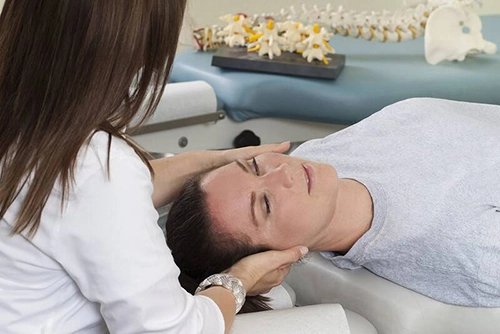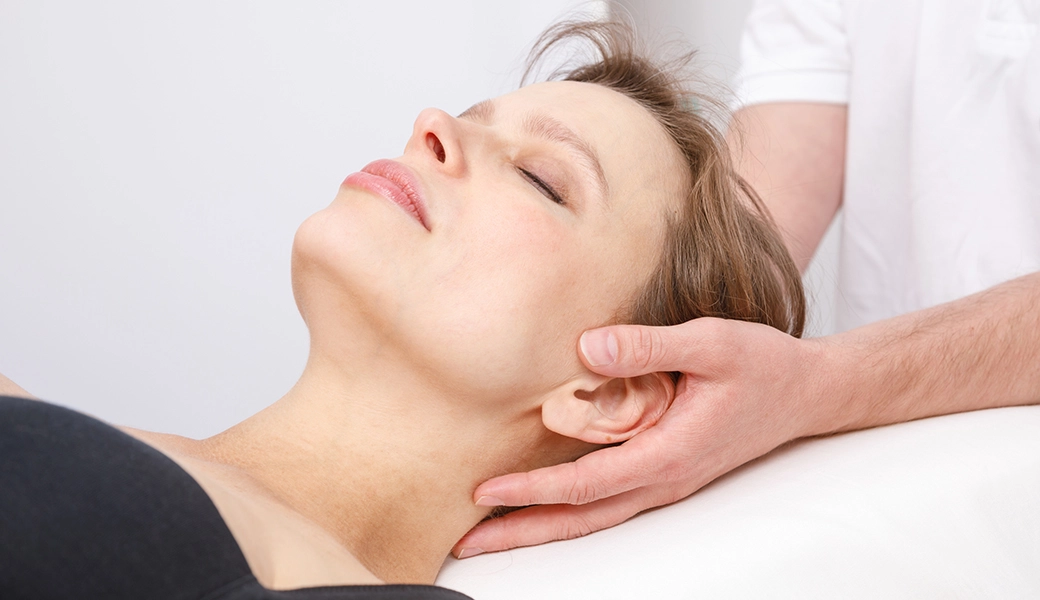Occipital Neuralgia is a painful, problematic type of headache. Treatment usually begins with a combination of conservative therapies incorporating various types of massage. Your trusted Anchorage chiropractor can give you more details.
Occipital Neuralgia (ON) is somewhat mysterious. It is not fully understood beyond the fact that it is a result of a disturbance to the Greater, Lesser, or Third occipital nerves. Initial conservative treatments of ON often include certain types of massage such as deep tissue massage, myofascial massage, and chiropractic massage in Anchorage, among others.
The Science of Occipital Neuralgia and Massage
A study in the Journal of the Canadian Chiropractic Association reports that 90% of reported cases of Occipital Neuralgia affect the Greater Occipital Nerve, 10% affect the Lesser Occipital Nerve, and 9% affect both.
The International Anesthesia Research Society reports on a case study of a 39-year-old woman with occipital neuralgia who, after some difficulties, was successfully treated with a combination of transcutaneous electrical nerve stimulation (TENS – a device often found at chiropractic offices), physical therapy, muscle relaxants, and deep tissue massage.
What concerns us here is massage. It is a common conservative form of treatment to help patients who suffer from headaches like Occipital Neuralgia. Let’s dig in, a little.
Do Massages Help Occipital Neuralgia? Experienced Chiropractor from Anchorage Gives the Answer.
It depends. Sometimes, depending upon what causes the patient’s Occipital Neuralgia, a massage will do the trick. Other times, it may require other types of therapy. In the worst of all possible worlds, a patient may have to resort to surgery to get relief. But not always.
As a rule, chiropractors, Anchorage-based or otherwise, operate under the notion that conservative therapies should be exhausted before more invasive techniques like surgery are tried. This is true whether you see a chiropractor for a headache or for some other musculoskeletal issue.
Since Occipital Neuralgia is a type of headache – and one that is not fully understood – it is often a good idea to try techniques that other types of headaches respond to. So, at the first sign of pain, the patient might want to try one or more of our natural tips for headache relief. They may help. They may not.
Occipital Neuralgia can be caused by a great number of different things. Some of these include:
- Tight muscles
- Tumors
- Diabetes
- Compressed nerves in the neck
- Inflamed blood vessels (vasculitis)
- Injury or trauma from sports or other activities
Although this is not a complete list of potential causes for ON, they serve our purposes here. Different causes for ON will likely require different treatments. For example, if your occipital neuralgia is caused by tight muscles in your neck, treating it may simply involve a few massage sessions to loosen up and relax those muscles. On the other hand, if it is caused by tumors (very rare), the ON might require surgery to treat.
Obviously, the simpler the treatment required, the happier the patient will probably be. Nobody wants to go under the knife unless it’s absolutely necessary. Massage is one of the simpler, and therefore one of the more commonly used, initial types of treatment.
Of course, the massage you will get at a chiropractor’s office isn’t limited to the general full-body massage you might get at a spa. It typically has a specific medical purpose (like relieving tight neck muscles for ON) and can consist of or incorporate elements from a variety of massage types. These include:
- Deep tissue massage
- Myofascial massage
- Chiropractic massage
- Acupressure
- Massage therapy
Which is the best for ON? Again, that depends on the particular causes of ON in the patient. Why are the occipital nerves being disturbed? Are they being compressed and impinged upon? Or is it something else? The answer will influence which type of massage is appropriate.
Massage therapy will reduce stress, improve range of motion, and help the patient sleep better. All of those may help reduce tension, pain, and stress caused by ON.

How Does Massage Release Occipital Neuralgia? Top Anchorage Chiropractor Explains
As I said above, the effectiveness of a massage in treating Occipital Neuralgia depends a great deal on the cause of Occipital Neuralgia. There may be some cases where a massage won’t work. But there will be other cases where it will.
Generally, massage is used to reduce tension, relax muscles, and stimulate blood flow. In many cases, occipital neuralgia can be traced back to muscles in the neck that have spasmodically tightened and impinged on one of the three Occipital Nerves. That tightness can be relieved by a skilled massage. Relieving the tightness will, in turn, help eliminate the pressure on the nerves caused by the impinging muscles. And, presto! The ON should dissipate.
Of course, this may not happen after just one session. Depending upon the severity of the ON and its root cause, a patient may need to undergo several massage sessions to find relief. And once relief is obtained, it is often a good idea to establish a regular regimen of chiropractic massage, under the guidance of your trusted Anchorage chiropractor. This will help keep the ON from returning.
Throughout this journey, as the ON gradually fades, the patient will have to learn some coping strategies to deal with the ON and keep it from disrupting their life as much as possible. Anyone with ON will know how difficult it can be to perform regular activities or to get to sleep when suffering from this kind of headache. Indeed, most sufferers will be well-pleased if they can find the best tips to sleep with occipital neuralgia or just some way to help them manage.
Occipital Neuralgia and Trigger Point Therapy
Another avenue for treating Occipital Neuralgia is through trigger point therapy. Trigger points often form as a result of injury or trauma to a muscle. The muscle contracts spasmodically in pain and, over time, adhesions form in the muscle fibers creating trigger points. Chiropractors have several different ways at their disposal to treat these trigger points.
First, there is trigger point therapy. This is, in a way, actually similar to massage – specifically, myofascial massage. In trigger point therapy, the chiropractor will alternate applying pressure and then releasing the pressure with his/her hands on the trigger point. The idea is to break up the adhesions, help the muscles relax, and provide relief. This is typically called “releasing” a trigger point.
Second, there is a trigger point injection. Basically, this involves injecting certain chemicals (like lidocaine, for example) into the trigger point to help the muscle relax, help relieve the pain, and help the trigger point release.
Scheduling Massage Therapy
If you suffer from Occipital Neuralgia, of course, you want to find relief as soon as you can. Schedule a session of massage therapy with Better Health Alaska. We are a chiropractic office in Anchorage with massage therapists and physical therapists on our staff. Our trained chiropractors and staff will be happy to see to your needs.
Sources:









